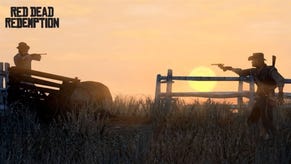Red Dead Redemption: Outlaws to the End
Let's go someplace like Bolivia.
We work our way around the perimeter of the town, ducking cannon blasts while eliminating gun emplacements in methodical succession. Every now and again there's an injection of Mexican army back up. The town sits in the centre of the playable environment, with enemies circling around, faced inward, ensuring our battle swirls dynamically like a whirlpool without corners of safety. It's strong level design.
"OK. That's the last of the Gatling guns. What now? Oh. You are kidding me. There's no way either of us is going to make it back into town to collect that dynamite."
Each mission is broken into sequential subtasks, providing a general sense of definition and purpose. In some missions these segments mimic the linear flow of the single player game: storm the fortress, rescue the girl, return her home and, finally, hold off the counter-attack. But in Artillery the sequence is more interesting, as you seek to expand your territory outwards from the centre of a giant dartboard. Now, having made it to the outer circles of our playpen, we must plant dynamite on a cliff top and bring the artillery placements down in a cascade of stone and thunder.
"OK. I'll go. Cover me and draw their fire."
"You draw their fire!"
"No, I'm going. Cover me."
"Oh gosh... Run!" I watch as a cannon ball traces a graceful arc across the sky and lands at Tom's feet.
"Aaargh. I DON'T BELIEVE IT. Is that what you call giving cover?"
"Is that what you call running? If I knew you were going to stroll..."

The stories that blossom from each of the scenarios may have been carefully orchestrated by Rockstar, but devoid of much in the way of narrative set-up or cut-scenes, they always feel improvised in play. The objectives are routine and simple, familiar from our exploits in single-player: defend yourselves as you float down the river on a raft, herd the livestock through the canyon, escort a kidnapped girl back to her family and so on. But in the spontaneous moments that arise within each, the game finds new-found freedom and stories.
Of course, there's a foundation of in-game rewards for those who prefer mathematics to romance. In addition to a clutch of achievements, there's a huge range of meta-objectives doled out for, for example, assisting an ally a certain number of times or completing a mission within a set time limit. Every one of these pays out experience points, which level your character across all of the game's multiplayer modes. In this way, Outlaws to the End not only beds with the existing multiplayer content, but enhances it dramatically.
"Are you sure the readers are going to appreciate hearing about our exploits?" Tom asks, as we wrap up for the night. "Shouldn't you be writing about ludo-narrative dissonance or, like, what the X button does?"
"Perhaps. But this is a co-op campaign add-on for a game pretty much everyone's played by now. I think they'll mostly want to hear about what happened when we played it."
"Yeah, sure. Haven't you realised that all anyone cares about is the score?"
"Tom, we've been playing this for five hours and in that time have only managed to actually finish one of these missions and get a score for our efforts. The score was literally the least important thing in motivating us to play. It's kind of irrelevant by this point."
"Right. I see what you're saying. Does that make it better or worse than Halo?"







